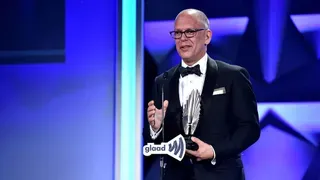August 12, 2014
Syphilis Cases Stabilized in First Half of 2014
Kilian Melloy READ TIME: 5 MIN.
During the first six months of 2014, early syphilis cases in San Francisco stabilized compared to the same time period a year prior, according to preliminary data released in July.
If the trend continues through December, it would mark the first time since 2008 that early cases of the sexually transmitted disease had not increased in the city compared to the previous year.
However, the public health department's STD prevention chief cautioned that the number of cases could swing upward in the fall, a pattern seen in previous years. And cases of chlamydia and gonorrhea show no signs of ebbing.
Deputy health officer Dr. Susan Philip. Photo: Rick Gerharter
In terms of syphilis cases, "it looks like, overall, some stabilization," said deputy health officer Dr. Susan Philip, the director of disease prevention and control in the health department's population health division. "What we have to remember is we have been looking at several years of increases. Sometimes, in prior years, we see increases in the fall or at the end of the year."
While Philip stressed it is "too soon" to determine what the overall STD outlook will be for 2014, she did say health officials "are encouraged" that early syphilis cases "are not higher at this point as it was last year."
According to the Department of Public Health's monthly STD report released July 16, which included data from January through the end of June, the city recorded 620 adult cases of syphilis. The number marked a slight decrease from the 635 such cases of syphilis recorded during the first half of 2013.
In terms of early cases of syphilis, known as primary and secondary, there were 224 in the first half of 2014, a 17.5 percent decrease from the 271 seen during the first six months of 2013.
"We are happy it is not higher, but it still remains to be seen what happens throughout the rest of the year," said Philip.
The city has yet to release its final report on STD cases for 2013. But based on preliminary numbers, as the Bay Area Reporter reported in February, early syphilis increased last year by 13.9 percent from 890 cases in 2012 to 1,014.
Syphilis has been on the rise across California and the country since 2001, according to federal health officials. Last month the Centers for Disease Control and Prevention reported that in 2012 the national syphilis rate rose to 4.6 per 100,000 people after having fallen to 4.5 in 2010.
The California Department of Public Health reported that, in 2013, the Golden State saw more than 3,500 cases of primary and secondary syphilis, almost 2,900 cases of early latent syphilis, and more than 3,600 cases of late latent syphilis.
"Any sexually active person can get an STD through unprotected sex," stated Dr. Ron Chapman, the department's director. "They should talk with their health care provider and ask if testing for STDs is appropriate."
Other STDs Continue Upward Trend
As for gonorrhea, the city saw cases increase by 345 in the first half of the year compared to the number recorded during the same period in 2013. Between January and June there were 1,460 cases; in 2013 the number was 1,115. Male rectal gonorrhea cases also increased, from 343 cases in the first half of 2013 to 392 so far this year.
According to the preliminary yearly data for 2013, reported gonorrhea cases increased 1.6 percent last year to 2,521 cases compared to the 2,481 in 2012. Additionally, rectal gonorrhea among men also increased from 780 cases to 794 cases in 2013, marking a 1.8 percent year-over-year increase, based on the preliminary data.
Chlamydia cases also continue to increase, with 2,778 so far in 2014 compared to the 2,525 seen during the first half of 2013. Male rectal chlamydia cases also continue to trend upwards, with 625 so far in 2014 compared to the 577 cases seen during the first half of 2013.
The city saw a 4.4 percent year-over-year increase in overall reported chlamydia cases last year, according to the preliminary data, for a total of 5,089 cases in 2013. Male rectal chlamydia also increased in 2013, according to the initial reports, from 1,081 to 1,167 cases for an 8 percent annual increase from 2012.
At the same time the city's federal funding from the CDC to combat STDs has decreased over the years, from more than $2 million in 2007 to roughly $1.5 million in 2013.
"The good news is that the city and DPH Director Barbara Garcia are very committed to ensuring we have strong STD prevention and services," said Philip.
As has been the case with past years, the majority of STD cases in San Francisco remain among sexually active gay and bisexual men. Health officials point to a variety of factors for why men who have sex with men are prone to contracting STDs.
Many HIV-positive men forgo using condoms by choosing to only partner with other HIV-positive men, a practice known as sero-sorting, thus increasing their risks for contracting STDs from their sex partners.
Negative men using pre-exposure prophylaxis, or PrEP for short, which entails taking a once-a-day pill, to protect themselves from contracting HIV who opt not to use condoms also put themselves at risk for STD transmission, warn health officials.
These new HIV prevention methods have led to a divergence between decreasing HIV rates in the city and rising STD rates. Health officials estimate there were 332 new HIV cases in the city in 2013, a drop from the 428 recorded in 2012.
Another contributing factor is health officials have made as a priority suppressing viral load in HIV-positive people by urging them to begin anti-retroviral treatment, which helps to decrease the chances of HIV transmission but has no impact on STD transmission.
"People are very smartly and accurately interpreting my risk of HIV transmission to a partner is much less if I am on treatment. People may think that if on PrEP as well," said Philip.
PrEP is "an effective tool," stressed Philip, that should be used to prevent HIV transmission. But those who are sexually active must also take steps to protect themselves from contracting an STD, she added.
"My view, and the view of the health department, is that in no way is it helpful to set up opposition between PrEP and STD prevention," said Philip. "My feeling is PrEP is good and we need to talk about overall sexual health, including PrEP and STD prevention."
In Los Angeles the AIDS Healthcare Foundation last month mounted a billboard that reads "California: #2 in Syphilis." Designed to replicate the state flag, it shows the grizzly bear holding its left front paw over its face in shame. It promotes the agency's website http://www.freeSTDcheck.org.
"There is no pill to prevent syphilis, or gonorrhea or any other sexually transmitted infection besides HIV," stated AHF President Michael Weinstein. "These infections spread easily and can be detrimental to public health if they are not mitigated by responsible health practices like regular condom use, which is still required for Truvada as PrEP to be effective anyway."
He added that the goal of the agency's latest campaign is "that people will be driven to contribute to decreasing these rates by preventing transmission in their own lives, and also to remind people that syphilis is a serious health risk that they need to be tested for to catch it before it causes significant damage to their organs."
In San Francisco Philip has floated convening a gay men's health summit in conjunction with community-based groups to discuss how to reduce STD rates. No date has been set yet for such a town hall discussion, as Philip only recently suggested it.
"Yes, it is something we have been talking about in the department," said Philip. "It is one of the things we have talked about to really get more data and feedback from the community given this potential divergence with HIV and STD prevention."
Health officials recommend that sexually active people be screened for STDs every three to six months. In terms of HIV, they recommend getting tested every six months.
Kilian Melloy serves as EDGE Media Network's Associate Arts Editor and Staff Contributor. His professional memberships include the National Lesbian & Gay Journalists Association, the Boston Online Film Critics Association, The Gay and Lesbian Entertainment Critics Association, and the Boston Theater Critics Association's Elliot Norton Awards Committee.






